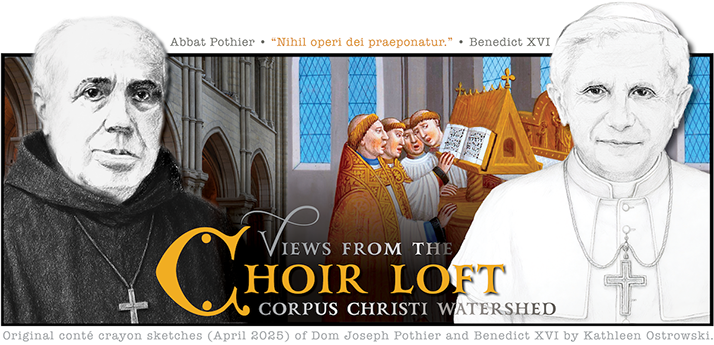
I confess to being a bit of a pragmatist when it comes to such questions as: “to repeat, or not to repeat?” My esteemed fellow bloggers will assuredly probe the philosophical depths of the question. For my part, I shall keep it short, sweet, and practical.
The Church’s patrimony of sacred music is so rich, so replete with material for most any occasion, that it seems on the surface we ought not need to repeat. But there are good reasons to repeat repertoire tastefully. Here are a few circumstances that, to my estimation, justify repetition:
1) When learning and reinforcing new repertoire. After all, repetitio mater studiorum!
2) When resources are limited (e.g. not enough time to adequately prepare new repertoire for the choir or organist; or if you are confined to working with limited acceptable choices in your parish hymnal; or if all your sopranos call in sick so you have to repeat a recent ATB selection; etc.)
3) When the piece in question is so beautiful, so remarkable, and so utterly capable of raising hearts and minds to God, AND your group executes the piece particularly well. As long as they aren’t overdone, some pieces never seem to get old for either singers or congregation, and the sense of peaceful familiarity they communicate can be a very powerful thing.
In our parish we have a few favorites that do see more repetition than others. A few hymns that tend to make the repetition list include Faith Of Our Fathers, Come Down O Love Divine, O God Almighty Father, and When I Survey The Wondrous Cross (Rockingham). Motets that our choir sings well and repeats when appropriate are DuFay’s Ave Maris Stella; Victoria’s Pange Lingua (More Hispano), O Vos Omnes, Ne Timeas Maria, and O Magnum Mysterium; and Hassler’s Dixit Maria. And at the organ console for postludes, I find myself coming back to the Finale from Widor’s 4th, the Dubois Toccata in G Major, Bach’s Gigue Fugue, and–purely because the congregation (and especially my chorister students) love it so much, despite my getting tired of it–the ubiquitous Toccata from Widor’s 5th Symphony.
It is important to note once more that the legitimate reasons to repeat are by no means an excuse to avoid the efforts of searching and learning new repertoire, whether chant, hymnody, motets, or organ literature. As I mentioned, we have such an incredible store of music for every liturgical occasion it’s almost mind-boggling! We do well to thoughtfully vary our music throughout the year in our hymns, our choir’s motets, and our organ selections. And yet, repetition is not only sometimes acceptable, it’s sometimes opportune for the quality execution of beautiful music in the service of the Liturgy. Even the chant propers themselves repeat from time to time, if not always in word, at least in theme and melodic motif.
Indeed, I, for one, choose to eschew the “never repeat” notion, and rather enjoy a thoughtful, well-planned repetition from time to time. The repertoire we employ is not an end in itself, but rather a means to an end, namely: the glorification of God and the edification of the faithful, in the context and within the well ordered confines of the Liturgy. If tasteful repetition serves that end, then by all means ||: repeat :||

